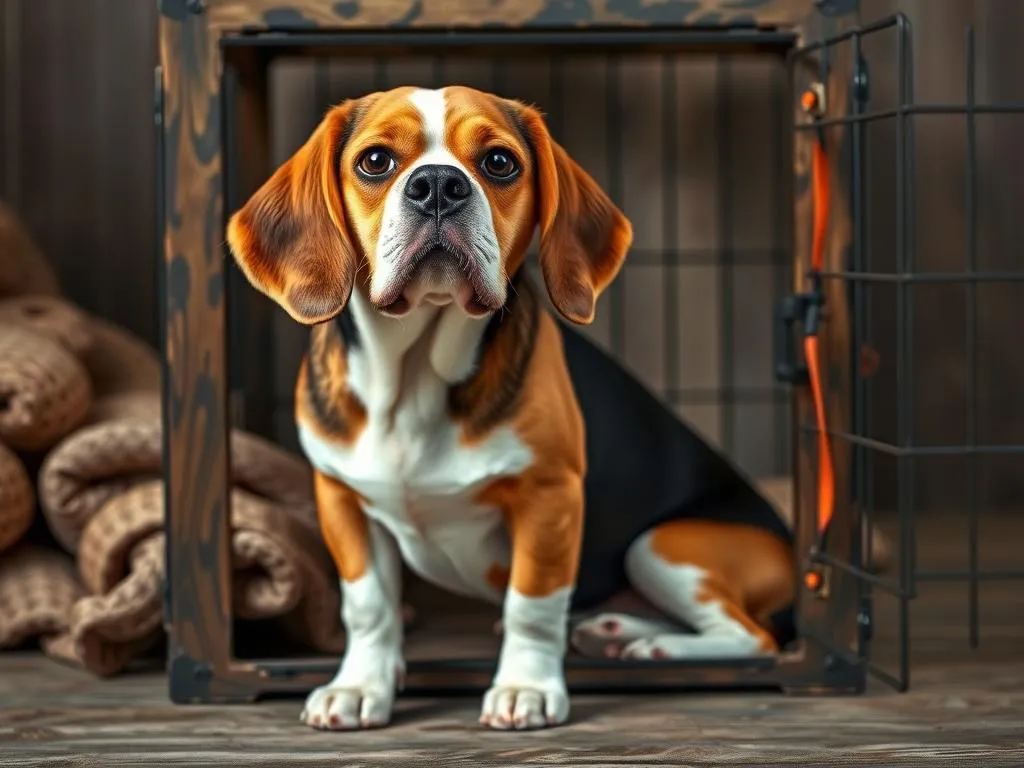
Crate training is an essential part of bringing a Beagle into your home. This breed, known for its curious and friendly nature, benefits greatly from having a safe and secure environment. Choosing the right crate size for your Beagle is crucial not only for their comfort but also for effective training. A well-sized crate can provide a sense of security, ease the housebreaking process, and serve as a cozy personal space for your pet.
Understanding Beagle Characteristics
Size and Weight
Beagles are a medium-sized breed, typically weighing between 20 to 30 pounds, depending on whether they are standard or miniature. Standard Beagles usually stand around 13 to 15 inches tall at the shoulder, while miniature Beagles are slightly smaller, measuring about 10 to 13 inches. Understanding these size variations is essential when selecting a crate, as it directly influences the overall comfort and well-being of your Beagle.
Temperament and Behavior
Beagles are known for their friendly disposition and curious nature. Their inquisitive behavior often leads them to explore their surroundings, making it necessary for their crate to provide ample space for movement. A Beagle’s temperament can influence how they react to being crated; they may feel anxious if confined in a space that feels too small. Therefore, recognizing the connection between their behavior and the crate’s size is vital for successful crate training.
The Importance of Crate Training
Benefits of Crate Training
Crate training offers numerous advantages for both Beagles and their owners. Firstly, it ensures safety by providing a secure space where your Beagle can relax without the risk of getting into trouble. Crates can also aid in housebreaking, as dogs naturally avoid soiling their sleeping area. Additionally, having a designated space helps foster a sense of security, allowing your Beagle to feel at home, especially during stressful situations.
Common Misconceptions
Many people mistakenly believe that crate training is cruel or unnecessary. In reality, crates can serve as a positive space for your Beagle. When introduced correctly, crates become a haven where they can retreat and feel secure. By addressing these misconceptions, you can better understand the role of crates in your Beagle’s life.
How to Measure Your Beagle for a Crate
Measuring Techniques
To determine the best crate size for your Beagle, accurate measurements are essential. Follow these steps:
- Length: Measure your Beagle from the tip of their nose to the base of their tail. Add a few inches for comfort.
- Height: Measure from the ground to the top of their head while standing. Again, add a few extra inches.
- Weight: Weigh your Beagle to ensure you choose a crate that can accommodate their size.
Understanding Growth Patterns
If you’re measuring a puppy, it’s crucial to consider their growth patterns. Beagles grow quickly, so plan for their future size when selecting a crate. Adjustable crates can be an excellent investment, allowing you to modify the space as your Beagle grows.
Choosing the Right Crate Size
General Sizing Guidelines
When selecting a crate for your Beagle, the general recommendation is to choose one that allows them to stand up, turn around, and lie down comfortably. A crate that is too small can cause anxiety and discomfort, while an oversized crate may lead to accidents inside.
Types of Crates
There are several types of crates available, each with its pros and cons:
- Wire Crates: These provide excellent ventilation and visibility, making them a popular choice. They are also collapsible, making storage easy.
- Plastic Crates: Often used for travel, plastic crates offer a more enclosed space, which can be comforting for some dogs. However, they may not provide as much ventilation as wire crates.
- Soft-Sided Crates: Ideal for travel or temporary use, these crates are lightweight and easy to transport. However, they may not be suitable for all Beagles, especially those who like to chew.
Crate Size Recommendations
The ideal crate size for Beagles generally falls within the following dimensions:
- Puppy Beagle: 24 inches long by 18 inches wide.
- Adult Beagle: 30 inches long by 21 inches wide.
- Senior Beagle: Depending on mobility, a crate similar to the adult size can be appropriate, but consider any special needs.
Look for adjustable crates that can grow with your Beagle, ensuring comfort at every stage of their life.
Setting Up the Crate for Your Beagle
Creating a Comfortable Environment
To make your Beagle’s crate inviting, consider adding the following:
- Bedding: Use soft, washable bedding to provide comfort.
- Toys: Include a few safe toys to keep your Beagle occupied.
- Safe Items: Familiar items, like a piece of your clothing, can help ease anxiety.
Training Your Beagle to Use the Crate
Introducing your Beagle to their crate should be a positive experience. Here are some tips:
- Start Slowly: Allow your Beagle to explore the crate at their pace. Leave the door open initially, so they can go in and out freely.
- Use Treats and Praise: Encourage your Beagle to enter the crate with treats and praise. Positive reinforcement is key to making the crate a happy place.
- Gradual Increases: Once your Beagle is comfortable entering the crate, gradually increase the time they spend inside with the door closed.
Common Issues and Solutions
Anxiety and Resistance
Some Beagles may show signs of anxiety when first introduced to a crate. Look for signs such as whining, barking, or attempting to escape. To help alleviate anxiety:
- Gradual Introduction: Allow your Beagle to adjust gradually, increasing crate time slowly.
- Comfort Items: Include items that smell like you to create a sense of security.
Overcoming Negative Associations
If your Beagle has developed a fear of their crate, it’s essential to address those negative associations. Here are strategies to help:
- Reassess the Environment: Ensure the crate is a safe, comfortable space, free from stressors.
- Positive Reinforcement: Use treats and praise to create new, positive experiences in the crate.
- Consistency: Be consistent with your training approach, allowing your Beagle to readjust at their own pace.
Conclusion
Choosing the best crate size for your Beagle is a vital part of their training and overall well-being. By understanding their characteristics and needs, you can select a crate that provides comfort and security. Remember, crate training is a process that requires patience and consistency. With the right approach, your Beagle will learn to love their crate as a safe haven.
Investing time in crate training and selecting the proper crate size will yield long-term benefits for both you and your Beagle, making your home a happier, more harmonious place for everyone.









